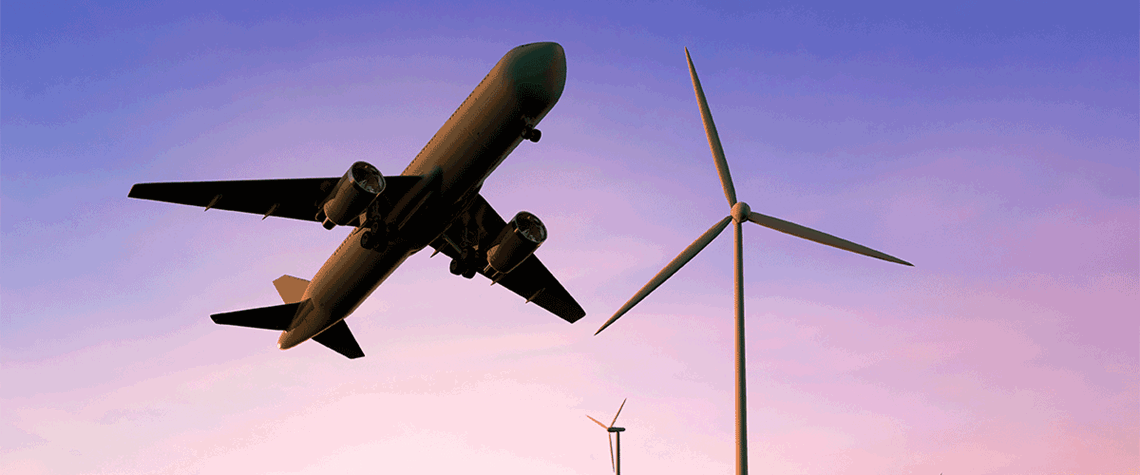Aviation is responsible for about 4pc of global warming, and while other sectors are already decarbonising, aviation is still on a massive growth pathway.
However, the pace at which the aviation sector is preparing its pathway to a sustainable future is accelerating. Just recently, the International Civil Aviation Organization (Icao) adopted an aspirational target to reach net zero by 2050. Now that goals are set, the question is: how do we get there?
Within the last two years, the aviation sector has been turned upside down, with Covid-19 hitting the airline industry hard. While global air traffic has experienced a considerable dent, it is set to rebound to pre-pandemic levels by 2024, with strong growth expectations of about 2–3pc/yr through 2050.
At the same time, aviation has increasingly been in the spotlight of climate discussions. In 2021, the International Air Transport Association increased its ambition from halving emissions by 2050 to achieving carbon neutrality by then. In October 2022, Icao, after years of diligent assessments, also adopted a long-term aspirational target to achieve net-zero emissions by 2050.
Toolkit to decarbonise aviation
Now, the question is: how can we achieve net zero while enabling a prosperous transition of the whole aviation industry to a greener, sustainable future?
To curb emissions from the aviation sector, there are five measures that need to be scaled simultaneously with immediate effect.
The first is reducing demand, such as by behaviourial change or a shift of short-haul flights to high-speed rail. The second is fuel efficiency gains, such as those from using more efficient turbines, more aerodynamic airframes or improved air traffic management. The third is the development of sustainable aviation fuels (SAFs). The fourth is the development of hydrogen, battery-electric and hybrid-electric aircraft. And the fifth is carbon dioxide removal required to counterbalance the residual emissions of SAFs, hydrogen and battery-electric aircraft—but which must not replace in-sector decarbonisation measures.
The Mission Possible Partnership (MPP)—a coalition of the Energy Transitions Commission, sustainability non-profits RMI and We Mean Business, and the World Economic Forum—estimates that fuel efficiency measures and SAFs could contribute about 85–95pc of cumulative emission reductions between 2022 and 2050. Fuel efficiency gains are crucial to reduce the energy demand of aircraft and counterbalance the additional fuel cost.
However, fuel efficiency measures cannot reduce emissions to close to zero—whereas SAFs can. Scaling SAFs is one of the main challenges the aviation sector needs to solve within this decade in order to decarbonise. There are three hurdles to overcome: the initially high green premium of SAFs needs to be bridged by policies, increased R&D and demand signals such as offtake agreements; the low technology readiness level of SAF production needs to be increased by de-risking measures such as blended finance or public-private partnerships; and sufficient, affordable feedstock needs to be supplied to the aviation sector, ranging from sustainable biomass to low-cost renewable electricity and captured CO₂.
Today, SAFs make up less than 0.1pc of global jet fuel supply. SAF production needs to be scaled by a factor of 500 by 2030 to achieve a 13–15pc share and by a factor of 5,000 by 2050 to reach 100pc of all fossil jet fuel being replaced with SAFs.
While it is crucial to lay the foundation for the massive scale-up of SAF production in this decade, it is also extremely difficult to achieve. New SAF plants have lead times of about 5–6 years, which leaves us (at the end of 2022) about two years to increase the current project pipeline of 8–9mn t of SAF to the required 40–50mn t by 2030. In addition to new plants, existing renewable fuel plants that currently serve the road transport sector could be repurposed to produce renewable jet fuel—which requires incentivisation through the right policies such as tax credits for biojet fuel rather than biodiesel. The electrification of cars could accelerate this trend by freeing up ethanol used for road transport to produce jet fuel.
What it will take to scale SAFs
The transition of global aviation to net zero will require large quantities of resources such as renewable electricity, green hydrogen, captured CO₂, and sustainable biomass—as well as massive investments across the entire value chain.
Today, global aviation relies almost entirely on fossil fuels. This will change dramatically in a decarbonised world. By 2050, global aviation could be responsible for 5–10pc of global electricity demand, 10–30pc of global green hydrogen demand and up to 25pc of global sustainable biomass supply. In a world of increasingly fierce competition for such low-carbon resources from multiple sectors, policymakers need to set smart guidelines to determine in which sectors to prioritise these resources.
Resource allocation should follow a merit order, channelling resources to the sectors that offer the largest reductions while considering market dynamics and a ranking of preferrable decarbonisation solutions. Take the example of biomass: while there are clear alternatives to biofuels for sectors such as trucking or shipping, aviation largely lacks those alternatives, especially for long-haul flights. Therefore, a larger share of the globally limited sustainable biomass supply should be directed to the aviation sector.
Through 2050, average capital investments need to increase to about $175bn/yr for SAF production facilities and corresponding upstream energy requirements, foremost for renewable electricity generation. While this is a massive challenge, the joint action of policymakers, industry pioneers and financial institutions can turn this into an investment opportunity in which the green premium—the cost differential between fossil jet fuel and SAFs—is translated from a burden into a first-mover advantage.
Maximillian Held is the lead aviation analyst at Energy Transitions Commission and Mission Possible Partnership.
This article is part of our special Outlook 2023 report, which features predictions and expectations from the energy industry on key trends in the year ahead. Click here to read the full report.








Comments